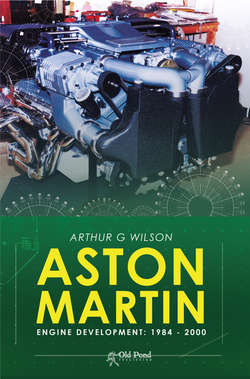Читать книгу Aston Martin Engine Development: 1984-2000 - Arthur Wilson L. - Страница 13
На сайте Литреса книга снята с продажи.
V12 Engine DP1080
ОглавлениеAnother interesting project was the development of the Ford Weslake race engine. In 1979, Aston Martin bought the rights, drawings and all tooling for the Ford Weslake V12 race engine. The thought at the time was that it could be developed as a four-litre engine for a new, smaller Aston Martin.
The engine had originally been designed as a 48-valve, three-litre V12 with 75 mm bore and 56.46 mm stroke, with the potential to stretch to four litres for sports car racing by opening the bore out to 80 mm and increasing the stroke to 66.2 mm. It should not be confused with the earlier Gurney Weslake Formula One engine, although the original engine design was based around the crank and main bearing arrangement for that engine. But the Ford Weslake engine has the benefit of having the five intermediate main bearing caps cross-bolted into the cylinder block for added stiffness.
The first prototype of this engine ran at the end of 1971 and in 1973 it is reputed that two engines were used for evaluation by JW Automotive in the Gulf Mirage endurance race car with favourable results. It was reputed to have been producing about 460 bhp at 10,500 rpm.
The AML development project number given to this engine project was DP1080. There was one complete engine, No. 006, included in our purchase and in April 1979 this was stripped to enable our chief engine designer, Alistair Lyle, to evaluate the design. The engine was then rebuilt in preparation for test bed development work. Our first run was 10 March 1980 and development continued on to the end of June. Initially we limited rpm to 10,000 but towards the end we ran to 11,000 rpm on occasions. We couldn’t equal the claimed output for this engine, at least not as fully stabilised readings. But it was an interesting project working on an out and out racing engine, and created some wonderful noises in the process. But at the end of the day it was decided that the cost of transforming it into a road car engine would be similar if not more expensive than starting from a clean sheet of paper. Also the stretch to four litres would be very questionable for a production road car.
Figure 4.1 Weslake V12 Power Curve.
The main features of the engine were:
• 60 degrees V12.
• Four gear-driven overhead camshafts.
• Lucas Mk II mechanical injection and Lucas RITA ignition.
• Slide throttles.
• Firing order 1-12-5-8-3-10-6-7-2-11-4-9, using the traditional AML method of cylinder numbering.
• 75 mm bore and 56.5 mm stroke giving a swept volume of 2996 cc.
• Crankshaft made from En40B.
• 60.4 mm main bearing.
• 41.24 mm big end journal, 120 degree throw.
• Pent roof combustion chamber.
• Inlet ports were angled at 45 degrees from cylinder axis.
• It was said that a 12/1 compression ratio had been achieved but from memory, the engine that we had was found to be around 11/1.
• The piston crown was extensively machined to provide clearance for valve movement and to maximise the compression ratio.
• Cylinder centres were 93.65 mm apart, allowing for a bore increase to 80mm. This combined with a longer stroke of 66.2 mm would give a swept volume of 3993.6 cc.
• The cylinder block and the cylinder heads were cast in LM25WP, other castings were in Magnesium.
• Dry sump lubrication system was via four oil pumps: two for crankcase scavenge, one for cylinder head scavenge and one for pressure feed to the engine.
• Weight was approximately 385lb: it was just under 32" long, 19" wide and 22" high.
• Maximum safe engine rpm was 11,500 rpm.
